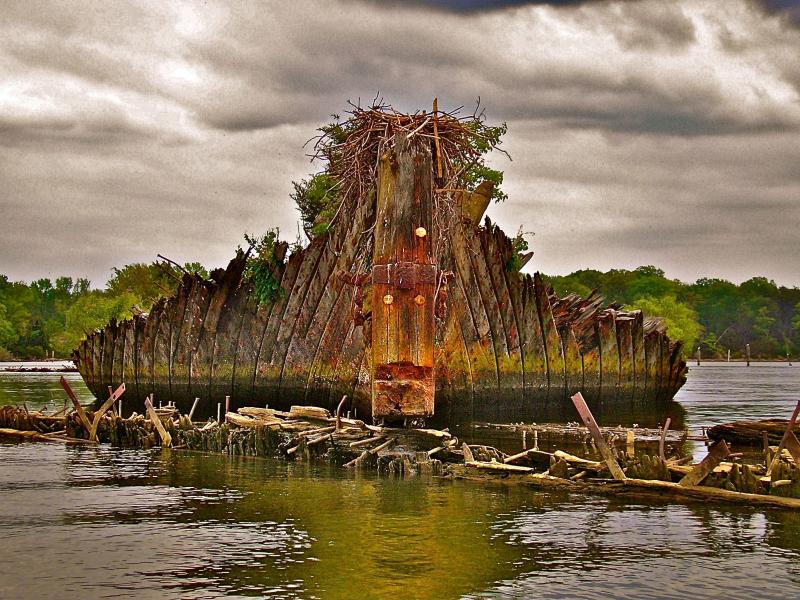Since its establishment in 1658, Charles County, Maryland has continually put its mark on our nation’s history through notable figures, landmarks, and monumental past events.
One of these landmarks is Mallows Bay, home to the “Ghost Fleet,” the largest ship graveyard in the Western Hemisphere.
Mallows Bay shipwrecks, which represent American conflicts dating back to the Revolutionary War through World War I, have become a sanctuary for a wide variety of wildlife species.
Mallows Bay Park features wildlife and shipwreck viewing areas with a permanent telescope, fishing, boating, kayak access, and a hiking trail.
Visitors can enjoy the scenic view of the bay’s waterscape dotted with tiny islands and scattered remains representing centuries of American history.
Across the bottom of Mallows Bay and the Potomac River are the remains of more than 100 wooden steam ships built between 1917 and 1919 for the World War I United States Emergency Fleet.
Now, on June 6, 2023, leaders in Maryland celebrated winning $5 million for the ecological restoration of Mallows Bay as part of a $2.6 billion investment in climate resilience projects across the country.
This historic investment – provided through the National Oceanic and Atmospheric Administration (NOAA) – is part of President Biden’s Investing in America Agenda which supports communities and people on the frontlines of climate change, particularly Tribes and vulnerable populations.
“Mallows Bay is one of Maryland’s great natural treasures, showcasing our unique marine biodiversity and ecology as well our state’s history and culture. Protecting sanctuaries like Mallows Bay is vital to both preserving our environment and our heritage, which is why we fought to pass the Inflation Reduction Act to bolster climate resiliency in Maryland and nationwide. This investment will help ensure that future generations of Marylanders will have the opportunity to experience everything that Mallows Bay National Marine Sanctuary has to offer,” said Maryland Senator Chris Van Hollen.
The funding was made possible by the lawmakers’ work to pass the Inflation Reduction Act and provide $3.3 billion for NOAA. The grant will be used to support coastal resilience and restoration projects that will help coastal communities adapt to changing climate conditions.
The framework for the $2.6 billion includes funding for technical assistance for capacity building, transformational projects that help protect communities from storms and flooding, the creation of quality climate-related jobs, and improved delivery of climate services to communities and businesses.
“For years we’ve worked to secure funding to build resilient infrastructure in Mallows Bay. The impacts of climate change have created a more urgent need to invest in protecting the health of Maryland’s estuaries, waterways and the communities that surround them,” said Senator Ben Cardin.
“This critical funding will ensure that we can make the needed improvements to keep Mallows Bay National Marine Sanctuary climate resilient for generations to come,” he added.
Mallows Bay-Potomac River is an 18-square mile area of the tidal Potomac River, adjacent to Charles County, Md.
Nearly 200 vessels spanning from the Revolutionary War through the present are found in the area, including the remains of the largest “Ghost Fleet” of World War I wooden steamships built for the U.S. Emergency Fleet, which are listed on the National Register of Historic Places.
“Our waters and coastal communities are a vital part of our state’s culture and economy, and we ought to do everything we can to protect them,” Congressman Steny Hoyer said.
“That includes safeguarding them from the growing threats of the climate crisis. I was proud to work with Senators Cardin and Van Hollen to secure key funding to build climate-resilient infrastructure in Mallows Bay, a location not just designated as a National Marine Sanctuary but also a National Treasure by the National Trust for Historic Preservation as well as the National Register of Historic Places. I will continue working with our Maryland Delegation, the Regional Leadership Council, and the Biden-Harris Administration to advance similar projects across the state and country and to ensure our Investing in America agenda is felt in every community across the country,” he continued.
Mallows Bay is largely undeveloped and has been identified as one of the most ecologically valuable natural areas in Maryland providing important habitat for fish and wildlife, including rare, threatened, and endangered species.
Mallows Bay-Potomac River was nominated to be a National Marine Sanctuary by former Governor Martin O’Malley in September 2014, and was endorsed by a diverse coalition of local, state, regional and national groups.
Photo courtesy of Charles County Government.

